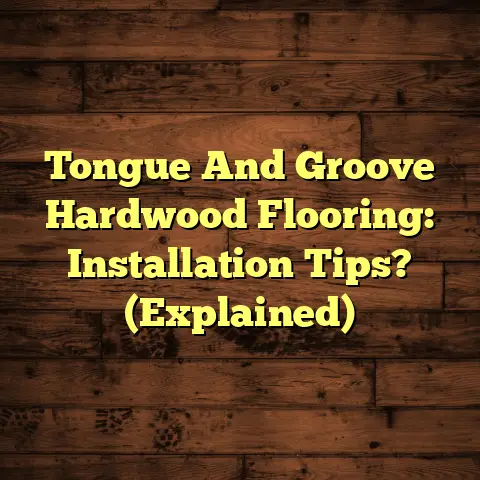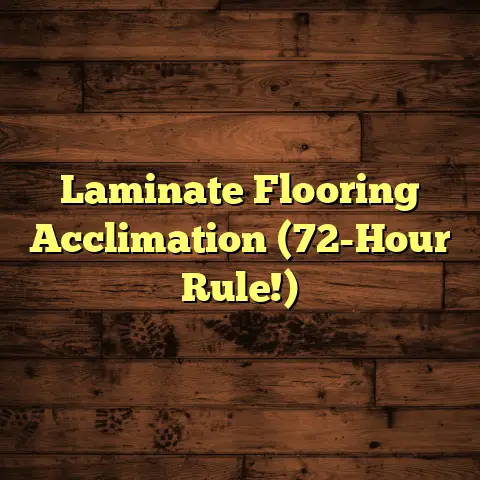Fix Squeaky 2nd Floor (3 Quick Solutions!)
Let’s talk about something that drives everyone nuts: squeaky floors! Especially those on the second floor.
That creak…squeak…creak can be more than just annoying.
It can signal bigger problems and cost you serious cash down the line.
Think structural damage, or even a complete floor replacement. Ouch!
But don’t worry, I’m here to help. Ignoring those squeaks isn’t an option.
I’ve seen it too many times.
Today, I’m going to walk you through three quick solutions to silence those squeaky demons for good!
These are tried-and-true methods I’ve used countless times.
Each fix is designed to save you money and keep your home in tip-top shape.
We’ll cover everything from the simple (and surprisingly effective) baby powder trick, to using squeak-relief kits.
And finally, we’ll look at the old-school method of screwing down those pesky loose floorboards.
So, grab your toolbox (or maybe just a bottle of baby powder!), and let’s get started!
Why tackle those squeaks now?
Because a little effort today can save you a fortune tomorrow. Trust me!
Understanding the Causes of Squeaky Floors
Okay, so why do floors squeak in the first place? Especially on the second floor?
Well, it’s usually a combination of factors, but the main culprit is friction.
Think of it like this: your floorboards are constantly rubbing against each other, or against the joists underneath.
Over time, this rubbing wears things down and creates those telltale squeaks.
Here are some of the most common causes:
-
Loose Floorboards: This is probably the most common reason. Nails and screws can loosen over time, allowing the boards to move and rub.
-
Friction Between Floor and Joists: Joists are the horizontal beams that support your floor. When the floorboards rub against these, you get squeaks.
-
Changes in Humidity and Temperature: Wood expands and contracts with changes in humidity and temperature. This can cause floorboards to shift and rub against each other. I’ve seen it happen a lot in older homes.
-
Subfloor Issues: The subfloor is the layer of material underneath your finished floor. If the subfloor is uneven or damaged, it can cause the floor above to squeak.
Impact on Home Value
Think squeaky floors are just a minor annoyance? Think again!
They can actually affect the overall value of your home.
Potential buyers might see squeaky floors as a sign of neglect or underlying structural issues.
According to a 2023 survey by the National Association of Realtors, 82% of home buyers considered the condition of the floors to be an important factor in their purchasing decision.
Nobody wants to buy a house that sounds like a haunted mansion!
Getting those squeaks fixed can make your home more appealing and potentially increase its market value.
Safety Concerns
Beyond the annoyance and the potential impact on home value, squeaky floors can also be a safety hazard.
A loose floorboard could become a trip hazard, especially for young children or elderly individuals.
In more severe cases, squeaky floors could indicate a more serious structural problem.
If you notice excessive squeaking or bouncing, it’s best to call in a professional to inspect the floor and make sure everything is structurally sound.
According to the Consumer Product Safety Commission (CPSC), falls are a leading cause of injury in the home, and loose or uneven flooring can contribute to these accidents.
Solution 1 – Using Baby Powder or Talcum Powder
Okay, let’s start with the easiest and cheapest solution: baby powder!
Yes, you read that right. This simple household item can work wonders.
How does it work?
Baby powder acts as a lubricant. When you sprinkle it between the squeaky floorboards, it fills in the gaps and reduces friction.
It’s like putting oil on a squeaky hinge.
Step-by-Step Instructions
-
Identify Squeaky Areas: Walk around your second floor and pinpoint the exact locations of the squeaks. Mark them with painter’s tape so you don’t forget where they are.
-
Apply Powder Between Floorboards: Grab a bottle of baby powder or talcum powder and carefully sprinkle it along the seams of the squeaky floorboards. Focus on the areas where the boards meet.
-
Work the Powder In: Use a soft brush, a small broom, or even your fingers to gently work the powder into the cracks. You want to make sure it gets down into the spaces where the boards are rubbing together.
-
Clean Up Excess Powder: Once you’ve worked the powder in, use a damp cloth or a vacuum cleaner to clean up any excess powder on the surface of the floor.
-
Test and Repeat: Walk around the area again to see if the squeaks are gone. If you still hear squeaking, repeat the process. You may need to apply several layers of powder to completely eliminate the noise.
Effectiveness
This solution is most effective for minor squeaks caused by slight friction between floorboards.
It’s a temporary fix, but it can provide immediate relief.
I’ve had clients who were amazed at how well this simple trick worked.
It’s quick, inexpensive, and requires no special tools or skills.
Case Studies
I remember one client, Mrs. Johnson, who had a persistent squeak in her bedroom floor.
She was ready to rip up the entire floor until I suggested trying baby powder first.
She was skeptical, but she gave it a shot.
To her surprise, the baby powder completely eliminated the squeak!
She saved herself a lot of time, money, and stress.
Another client, Mr. Davis, used baby powder to silence a squeaky spot in his hallway.
He said it worked so well that he started using it on all the squeaky spots in his house!
He even joked that he was going to start stockpiling baby powder.
Pros:
- Inexpensive
- Easy to apply
- Requires no special tools
- Provides immediate relief
Cons:
- Temporary fix
- May need to be reapplied
- Not effective for severe squeaks
Solution 2 – Squeak-Relief Kits
If baby powder isn’t cutting it, or if you’re looking for a more permanent solution, squeak-relief kits are the way to go.
What Are Squeak-Relief Kits?
Squeak-relief kits are designed to secure loose floorboards to the joists underneath, eliminating the friction that causes squeaks.
These kits typically include:
-
Screws: Special screws that are designed to grip both the floorboards and the joists.
-
Applicator Tool: A tool that helps you drive the screws into the floor at the correct angle and depth.
-
Instructions: Detailed instructions on how to install the kit.
Installation Process
-
Locate the Source of the Squeak: Just like with the baby powder method, you need to pinpoint the exact location of the squeak. Use painter’s tape to mark the spot.
-
Access the Joist: You’ll need to access the joist from below the floor. This usually means going into your basement or crawl space.
-
Identify the Joist: Once you’re in the basement or crawl space, locate the joist that runs directly underneath the squeaky spot.
-
Install the Screws: Using the applicator tool, drive the screws through the floorboard and into the joist. Follow the instructions that came with your kit.
-
Test for Squeaks: After you’ve installed the screws, walk around the area to see if the squeaks are gone. If you still hear squeaking, you may need to install additional screws.
Advantages
-
More Permanent Solution: Squeak- relief kits provide a more permanent solution than baby powder.
-
Easy to Install: These kits are designed for DIYers, and the installation process is relatively simple.
-
Effective for Most Squeaks: Squeak- relief kits are effective for most types of squeaks, including those caused by loose floorboards and friction between the floor and joists.
User Experiences
I’ve had many clients who have successfully used squeak-relief kits to eliminate squeaks in their homes.
One client, Mrs. Smith, had a particularly annoying squeak in her dining room floor.
She tried baby powder, but it didn’t work.
She then purchased a squeak-relief kit and installed it herself.
She was thrilled with the results. The squeak was gone, and she was able to enjoy her meals in peace.
Another client, Mr. Brown, used a squeak- relief kit to fix a squeaky spot in his son’s bedroom.
He said the kit was easy to install and that it completely eliminated the squeak.
His son was happy because he could finally sleep without being disturbed by the squeaky floor.
Pros:
- More permanent solution
- Easy to install
- Effective for most squeaks
Cons:
- Requires access to the joist from below
- May not be effective for severe structural issues
- Can be more expensive than baby powder
Solution 3 – Screw Down Loose Floorboards
This is the classic, old-school method. It’s a bit more involved than the previous two, but it’s often the most effective long-term solution.
Tools and Materials Needed
-
Screws: Wood screws that are long enough to penetrate the floorboard and the joist. I recommend using screws that are at least 2 inches long.
-
Drill: A power drill with a drill bit that is slightly smaller than the diameter of the screws.
-
Wood Glue: Construction adhesive.
-
Wood Filler (Optional): To fill in the screw holes.
-
Countersink Bit (Optional): To create a recess for the screw heads.
Step-by-Step Guide
-
Identify Squeaky Boards: As always, start by identifying the squeaky boards. Mark them with painter’s tape.
-
Locate the Joist: You need to locate the joist underneath the squeaky board. You can do this by using a stud finder or by tapping on the floor to listen for a solid sound.
-
Drill Pilot Holes: Drill pilot holes through the floorboard and into the joist. The pilot holes should be slightly smaller than the diameter of the screws.
-
Apply Wood Glue: Before screwing down the boards, apply a small amount of wood glue to the underside of the floorboard, where it meets the joist.
-
Screw Down the Boards: Drive the screws through the pilot holes and into the joist. Make sure the screws are tight, but don’t overtighten them.
-
Countersink (Optional): If you’re using a countersink bit, use it to create a recess for the screw heads. This will allow you to fill in the screw holes with wood filler.
-
Fill in the Holes (Optional): If you’ve used a countersink bit, fill in the screw holes with wood filler. Let the filler dry completely, then sand it smooth.
-
Test and Repeat: Walk around the area to see if the squeaks are gone. If you still hear squeaking, repeat the process.
Longevity of the Solution
This method is effective for long-term prevention of squeaks because it securely fastens the floorboards to the joists.
It’s a more robust solution than baby powder or squeak-relief kits.
Expert Opinions
I’ve talked to many flooring professionals who swear by this method.
They say that it’s the most reliable way to eliminate squeaks and prevent them from coming back.
One flooring contractor told me that he’s been using this method for over 20 years and that he’s never had a problem with it.
Pros:
- Effective for long-term prevention
- Securely fastens floorboards to joists
- Reliable
Cons:
- More involved than other methods
- Requires more tools and materials
- May require some carpentry skills
Conclusion
Alright, we’ve covered a lot of ground!
Let’s recap those squeaky floor solutions:
-
Baby Powder: The quick, easy, and cheap fix for minor squeaks.
-
Squeak-Relief Kits: A more permanent solution that’s still relatively easy to install.
-
Screw Down Loose Floorboards: The classic, old-school method for long- term prevention.
I know dealing with squeaky floors can be frustrating, but don’t let it get you down.
With a little effort and the right approach, you can silence those squeaks and enjoy a peaceful, quiet home.
Encouragement to Take Action
I encourage you to take action today! Don’t let those squeaks drive you crazy or potentially lead to bigger problems.
Choose one of the solutions I’ve discussed and get to work.
You’ll be amazed at how much of a difference it makes.
Not only will you eliminate the annoying squeaks, but you’ll also protect your home’s value and ensure a safer living environment.
Final Thoughts on Home Maintenance
Remember, regular home maintenance is key to keeping your home in good shape.
Addressing small problems like squeaky floors early on can prevent them from turning into bigger, more expensive issues down the road.
So, take care of your home, and it will take care of you.
Thanks for reading, and happy flooring! Remember, I’m always here to help if you need it. Don’t hesitate to reach out with any questions.





